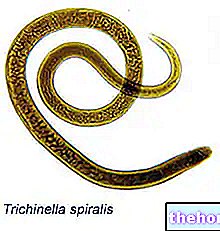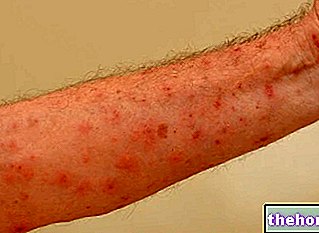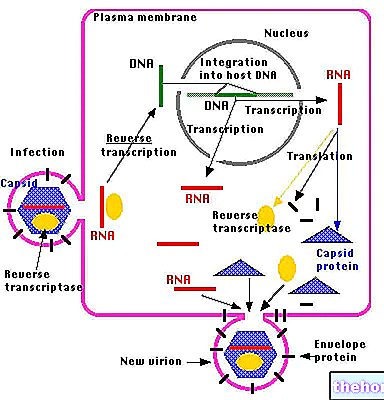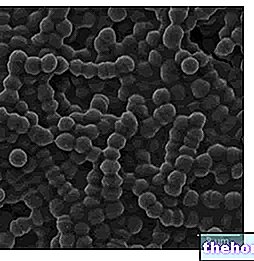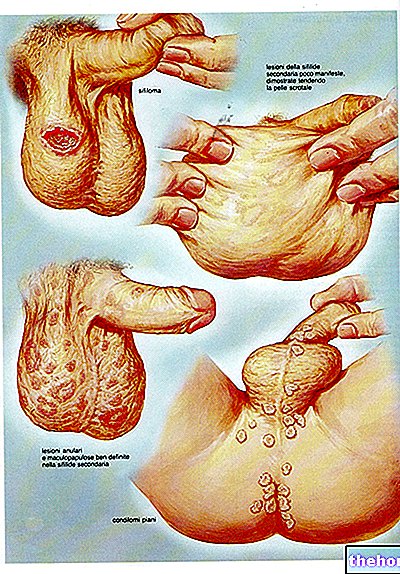Generality
Rotavirus is the viral agent responsible for most juvenile cases of gastroenteritis.

Typically, the symptoms of rotavirus gastroenteritis consist of: nausea, vomiting, fever and watery diarrhea.
The most feared complication is dehydration, following repeated episodes of vomiting and dysentery.
In most cases, physical examination and history are sufficient to detect rotavirus infection.
There are no specific treatments, only symptomatic treatments.
The rehydration of the patient is fundamental to avoid serious complications.
What is rotavirus?
Rotavirus is the biological agent that is the leading cause of gastroenteritis in infants and children.
Having several double-stranded RNA molecules per genome, rotavirus belongs to the viral family known as Reoviridae.
What is gastroenteritis
With the term gastroenteritis, doctors mean "inflammation of the stomach and intestines".
Generally, gastroenteritis has an infectious origin; however, in some cases, it can arise as a result of the ingestion of toxic metals, drugs, plants or fungi.
ROTAVIRUS SPECIES
To date, virologists have identified 8 species of rotavirus, identified with the first eight capital letters of the alphabet, then A, B, C, D, E, F, G and H.
Of the 8 Rotavirus species identified so far, Rotavirus A species is the most widespread. This, in fact, is responsible for more than 90% of so-called rotavirus infections.
SOME FEATURES OF THE ROTAVIRUS
The rotavirus genome consists of 11 double-stranded RNA molecules, identified with the Arabic numbers 1 to 11.
Taken together, these 11 double-stranded RNA molecules possess exactly 18,555 nucleotides.
Except for RNA molecule number 9 - which codes for two genes - all other RNA molecules code for only one gene.
Rotavirus is a particle whose diameter measures 76.5 nanometers.
HISTORY OF THE ROTAVIRUS
The credit for the discovery of the rotavirus belongs to the Australian virologist Ruth Bishop and her team of colleagues. It was the year 1973.
The "introduction into medical jargon of the term" rotavirus "dates back to 1974: the word was coined by another virologist, a certain Thomas Henry Flewett, who under the electron microscope noticed the particular wheel shape of the rotavirus (" rota "is the Latin term which, in Italian, means "wheel").
Starting in 1980, researchers studying rotavirus began to identify the various viral species existing in nature and capable of infecting humans.
EPIDEMIOLOGY
According to some statistical studies, rotavirus would cause millions and millions of infections every year, resulting in about 2 million hospitalizations and causing the death of almost 453,000 children under 5 years of age.
However, it should be noted that, since rotavirus vaccines have existed, the annual number of rotavirus infections is clearly decreasing (obviously in countries where vaccination is possible).
Rotavirus is so common that, in the opinion of doctors and virologists, almost all children contract the aforementioned viral agent at least once within the first 5 years of life.
The likelihood of developing rotavirus infection is greatest during cold and / or dry seasons.
In the adult population, rotavirus infections are very rare.
Rotavirus in the USA before the vaccine
Before making vaccines ad hoc, in the USA, every year, the cases of rotavirus infection were about 2.7 million.
Of these 2.7 million cases of infection, about 60,000 required hospitalization and about 37 caused the death of the individual concerned.
Causes
Transmission of rotavirus can occur in several ways:
- Via the so-called fecal-oral route (fecal-oral transmission). This mode of transmission means that the pathogen is able to find itself in the faeces.
In the specific case, the rotavirus has the aforementioned ability. - Through physical contact with hands, surfaces, food or contaminated objects.
- Through the respiratory tract. In this case, the viral agent is transmitted by small volatile droplets of saliva, which expel infected people when they talk, sneeze, cough, etc.
The fecal-oral transmission is, by far, the most widespread and the one that causes the greatest number of infections. After all, consider that the feces of a subject infected with rotavirus contain about 10 trillion viral particles per gram and that less than 100 viral particles per gram are sufficient to develop rotavirus gastroenteritis.
SOME CURIOSITIES ABOUT ROTAVIRUS TRANSMISSION
Rotavirus is quite stable in the environment and is capable of surviving there, waiting to infect someone, for a period of time ranging from 9 to 19 days.
Furthermore, it is curious how, in countries of the world where health measures are inadequate, the rate of incidence of rotavirus infections is comparable to the rate of incidence of rotavirus infections calculated for the countries of the world where health measures are "vanguard.
RISK FACTORS
The subjects most at risk of rotavirus infection are children between the ages of 3 and 35 months.
Symptoms and Complications
Symptoms and signs of a rotavirus infection appear approximately two weeks after exposure to the pathogen. Thus the rotavirus incubation period is approximately 14-15 days.
The resulting gastroenteritis, which can be moderate or severe, initially results in a mild fever, nausea and vomiting; later (usually after 3-7 days), recurrent episodes of watery diarrhea (or dysentery) and severe abdominal pain appear.

ROTAVIRUS IN ADULTS
In adults who are in good health, rotavirus infections cause very mild, often almost imperceptible, manifestations.
In other words, they are partially or totally asymptomatic.
Why are adults less prone to rotavirus infections?
Adults are less prone to rotavirus infections for at least two reasons:
- They probably already contracted the virus at a young age, so they developed "antibody immunity that protects them from later infections."
- They have a mature and more effective immune system than a child's.
HOW ROTAVIRUS CAUSES GASTROENTERITIS
From a pathophysiological point of view, rotavirus causes gastroenteritis because, when it enters the body, it attacks and destroys enterocytes.
Enterocytes are the epithelial cells that line the inner wall of the small intestine; in this case, they are the cellular elements that cover the intestinal villi.
WHEN TO SEE THE DOCTOR?
In the case of patients of young or very young age, it is advisable to contact the doctor in the presence of:
- Diarrhea for more than 24 consecutive hours
- Recurrent vomiting
- Black stools or stools containing blood and / or traces of pus
- Fever of 40 ° C or higher
- Lethargy, irritability and / or severe pain
- Dehydration
In the case of adult patients, it is advisable to consult a doctor in the presence of:
- Episodes of diarrhea at least twice a day
- Inability to retain ingested fluids for more than 24 hours
- Vomiting with blood
- Repeated bowel movements
- Fever of 39 ° C or higher
- Dehydration
COMPLICATIONS
The most important complication of rotavirus infections is dehydration following recurrent episodes of watery diarrhea.
If not treated in time and in the right way, dehydration can even lead to death.
- Vertigo in getting up from a sitting position
- Decrease in urination
- Dry mouth
- Weep without tears
- Unusual sleepiness
- Great sense of thirst
- Sense of weakness
- Dizziness
Diagnosis
Rotavirus causes an "infection that doctors usually diagnose through a careful physical examination and a" medical history (medical history).
If doubts remain, the examination that allows us to definitively clarify the origin of the diarrhea and the other symptoms of gastroenteritis is the analysis of a sample of the patient's stool.
The fecal sample analysis includes a series of laboratory tests aimed at detecting rotavirus.
Treatment
The treatments available, for the treatment of rotavirus infections, are non-specific and essentially consist of symptomatic therapies. A symptomatic therapy is a therapeutic intervention aimed at improving the symptomatic picture.
Among the various symptomatic remedies, maintaining the hydration of the infected subject is very important. If the fluid intake is adequate to the patient's requirements, the risk of complications is minimal and the chances of recovery are high.
REHYDRATION: WHAT DOES IT CONSIST?
The rehydration of a subject with a rotavirus infection consists in the administration of liquids based on water, mineral salts and sugars.
Mineral salts are particularly important, as vomiting and diarrhea cause a great loss.
WHAT TO DO IN CASE OF SEVERE DEHYDRATION?
If rotavirus infection has caused severe dehydration, the affected patient should be hospitalized and given intravenous rehydration fluids.
DO YOU NEED DRUGS AGAINST DIARREA?
Generally, the treatment of rotavirus infections does not involve the administration of anti-diarrhea drugs (antidiarrheal drugs).
This indication is also valid for those infectious states characterized by severe dysentery.
Prognosis
Typically, if the patient recovers the fluids they lose due to diarrhea and / or vomiting, a classic rotavirus infection resolves within 3-7 days, without repercussions of any kind.
Prevention
As mentioned, the possibility exists today to get vaccinated against rotavirus.
To be more precise, there are two types of vaccines, both of which are very effective and safe. These two types of vaccines specifically protect against rotavirus of species A, fall into the category of live attenuated vaccines and are taken orally. To consult the relevant data sheets, see the summary of the characteristics of the Rotarix and RotaTeq vaccines.
The marketing of rotavirus A vaccines is quite recent. In fact, it dates back to 2006 (obviously after a long series of experiments).
Currently, more than 100 countries in the world are licensed to use the aforementioned vaccines, but only 28 of these have introduced the rotavirus vaccine as a routine vaccination.


